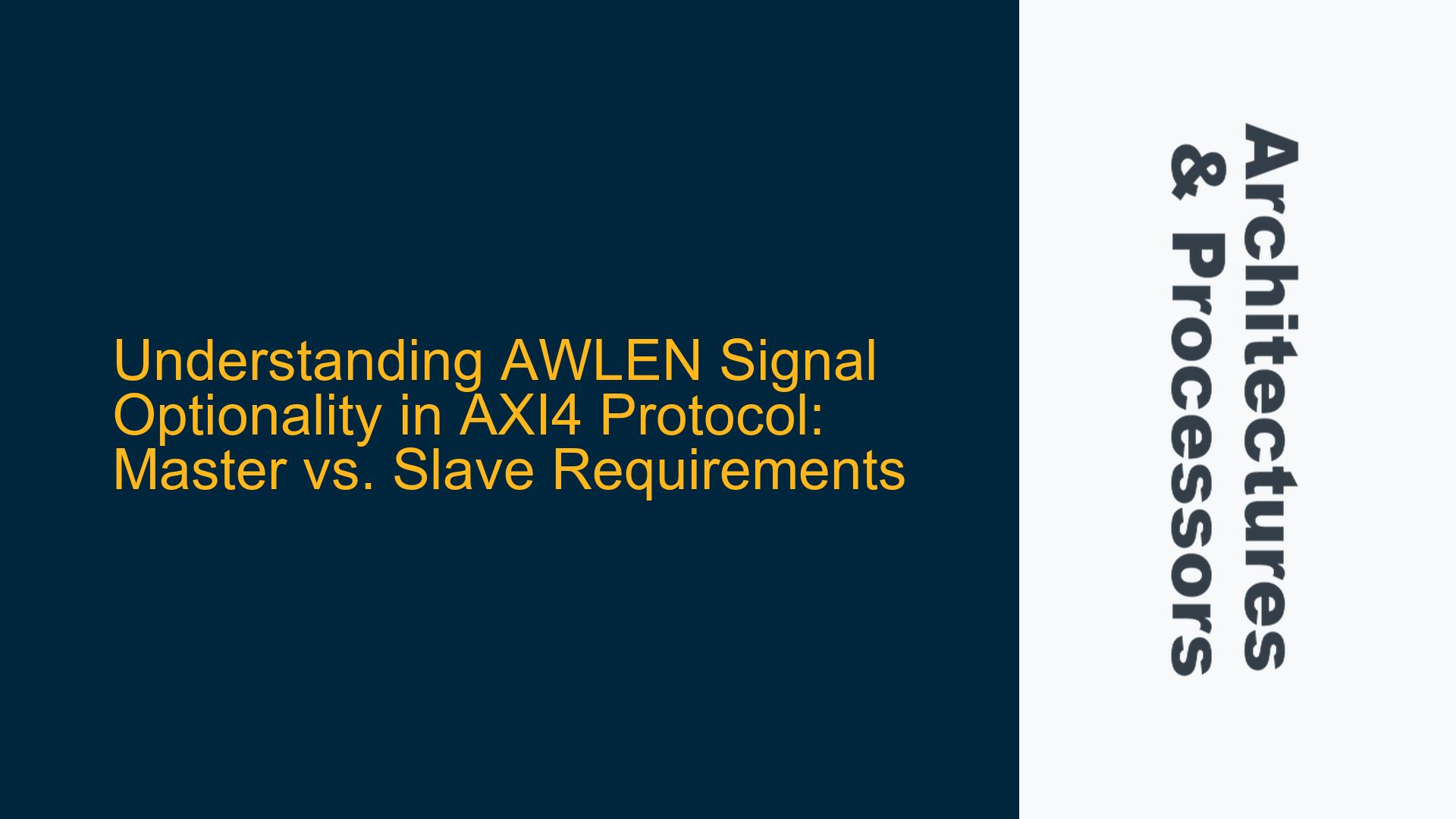AWLEN Signal Optionality in AXI4 Masters and Its Implications for Slaves
The AWLEN signal in the AXI4 protocol is a critical component of the write address channel, responsible for indicating the number of data transfers in a burst transaction. The AXI4 specification describes AWLEN as optional for masters but mandatory for slaves, which raises questions about how the protocol ensures consistency and functionality when the signal is not explicitly driven by the master. This section delves into the architectural reasoning behind this design choice, the implications for both masters and slaves, and the mechanisms that ensure proper operation even when AWLEN is not explicitly implemented by the master.
In the AXI4 protocol, the AWLEN signal is an 8-bit field that specifies the number of transfers in a burst, minus one. For example, an AWLEN value of 0 indicates a single transfer, while a value of 7 indicates eight transfers. The optionality of AWLEN for masters stems from the fact that many masters only perform single-transfer transactions, which is the default behavior when AWLEN is not implemented. In such cases, the master does not need to drive the AWLEN signal, and the slave can assume a default value of 0, corresponding to a single transfer.
However, the slave must always implement the AWLEN signal because it needs to interpret the burst length for every transaction, regardless of whether the master drives the signal or not. This asymmetry between master and slave requirements ensures that the protocol remains flexible for masters while maintaining strict compliance for slaves. The slave’s ability to handle the default value of AWLEN when the master does not implement it is a key aspect of this design.
The AXI4 specification provides clear guidelines for handling optional signals like AWLEN. Table A9.3 in the specification outlines the default values for optional signals, ensuring that slaves can operate correctly even when certain signals are not driven by the master. This design choice simplifies the implementation of simple masters while ensuring that slaves remain robust and capable of handling a wide range of transactions.
Default Signal Handling and Its Role in AXI4 Protocol Compliance
The handling of default signals in the AXI4 protocol is a fundamental aspect of its design, enabling flexibility for masters while ensuring compliance and robustness for slaves. The AWLEN signal is a prime example of this mechanism, as its optionality for masters relies on the use of default values when the signal is not implemented. This section explores the technical details of default signal handling, its impact on protocol compliance, and the implications for both master and slave designs.
When a master does not implement the AWLEN signal, the AXI4 protocol specifies that the signal should be treated as having a default value of 0. This default value corresponds to a single transfer, which is the simplest form of transaction. By allowing masters to omit the AWLEN signal and rely on this default value, the protocol reduces the complexity of master designs that only perform single-transfer transactions. This is particularly beneficial for simple peripherals or control logic that do not require burst transactions.
For slaves, the handling of default values is a critical part of their design. Slaves must be capable of interpreting transactions correctly even when optional signals like AWLEN are not explicitly driven by the master. This requires slaves to implement logic that detects the absence of these signals and applies the appropriate default values. In the case of AWLEN, the slave must assume a value of 0 when the signal is not present, ensuring that the transaction is processed as a single transfer.
The use of default values also has implications for protocol compliance and verification. Verification environments must ensure that slaves correctly handle default values for optional signals, as this is a key requirement of the AXI4 specification. This involves testing scenarios where optional signals are not driven by the master and verifying that the slave behaves as expected. Additionally, synthesis tools must be configured to handle default values correctly, ensuring that the resulting hardware meets the protocol’s requirements.
Implementing Robust AXI4 Slaves with Optional Signal Support
The implementation of AXI4 slaves that support optional signals like AWLEN requires careful consideration of the protocol’s requirements and the specific needs of the design. This section provides detailed guidance on designing and verifying AXI4 slaves that can handle optional signals correctly, ensuring compliance with the protocol and robust operation in a variety of scenarios.
The first step in implementing an AXI4 slave with optional signal support is to understand the protocol’s requirements for default values. As discussed earlier, the AXI4 specification provides default values for optional signals, which must be applied when these signals are not implemented by the master. For the AWLEN signal, the default value is 0, corresponding to a single transfer. The slave’s design must include logic to detect the absence of the AWLEN signal and apply this default value.
In RTL design, this can be achieved by using conditional logic to check whether the AWLEN signal is connected. If the signal is not connected, the slave should internally generate the default value of 0. This ensures that the slave can handle transactions correctly regardless of whether the master implements the AWLEN signal. The following example illustrates this approach in SystemVerilog:
logic [7:0] awlen_internal;
assign awlen_internal = (AWLEN_ENABLED) ? AWLEN : 8'b0;
In this example, AWLEN_ENABLED is a parameter that indicates whether the AWLEN signal is connected. If the signal is not connected, the slave uses the default value of 0.
Verification of the slave’s handling of optional signals is a critical part of the design process. The verification environment must include test cases that cover scenarios where optional signals are not driven by the master. This ensures that the slave correctly applies default values and processes transactions as expected. UVM-based testbenches can be used to create these scenarios, with sequences that selectively omit optional signals like AWLEN.
In addition to functional verification, timing analysis is also important to ensure that the slave’s handling of optional signals does not introduce timing violations. Synthesis tools must be configured to handle default values correctly, and timing constraints should be applied to ensure that the slave meets the protocol’s timing requirements.
By following these guidelines, designers can implement robust AXI4 slaves that support optional signals like AWLEN, ensuring compliance with the protocol and reliable operation in a variety of scenarios. This approach simplifies the integration of masters and slaves in complex SoC designs, enabling efficient and flexible system architectures.






